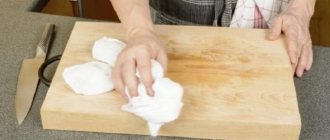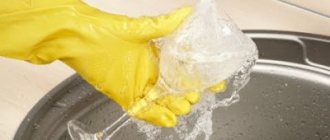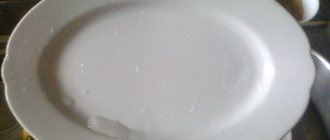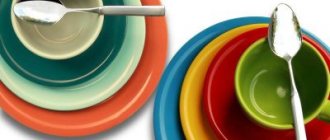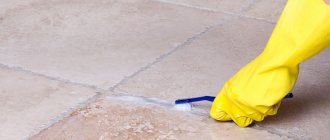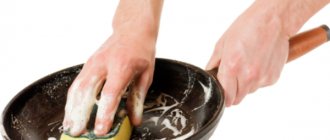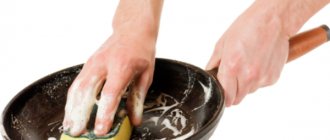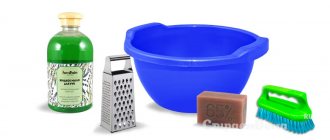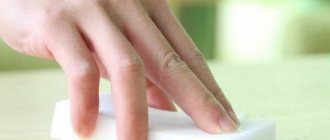You can safely take plastic dishes with you on the road, put food in plastic containers for a snack at work, or put food supplies in the refrigerator. Plastic is a very practical material, and when used correctly, it is also durable. How to wash it correctly, and most importantly, what to do with plastic dishes at home so that they look like new for as long as possible?
How to clean a plate from old fat?
A large basin or pan with dirty dishes is filled with hot water (2-3 tablespoons of soda per 1 liter of water) for 1 hour. After the necessary time, the dishes are thoroughly washed with a sponge under running water. Citric Acid: Great for cleaning the backs of plates of grease deposits.
Interesting materials:
Who comes up with the names for Ikea? Who comes up with the names? Is it possible to change the name of an Instagram account? Is it possible to remove the operator name on an iPhone? What language did the Romans speak and why is it called that? Do I need to put English names in quotes? Do I need to put a comma before called? Where did the name of the city Karaganda come from? Where do the names Artik and Asti come from? Where does the name avocado come from?
How to Manually Clean Plastic Food Containers
Those plastic containers that need to be cleaned quickly or that will not tolerate washing in a washing machine will have to be washed by hand.
You will need:
- Dish detergent
- Water
- Soft rags or sponges
- Towels
How to clean plastic food containers:
- Fill the sink with warm water.
- Add a small amount of dish soap and mix well.
- Dampen a cloth with soapy water and wring it out until damp.
- Wipe the inside and outside of the plastic food container with a sponge or rag.
- If the plastic container can fit completely under water, then immerse it in water and wipe it thoroughly on all sides with a sponge or cloth.
- Wipe the lunch box with a damp cloth soaked in clean water.
- Dry the box with a towel.
- Before reusing a plastic food container, allow it to dry completely outdoors. If the lunch box was completely submerged in water when cleaning, this step is especially important as the seal will likely still be wet.
Laundry soap
This product will help renew the color of the plastic and remove stubborn stains:
- chop half the block on a grater;
- pour boiling water over the mixture and leave until the soap is completely dissolved;
- apply the paste to the contaminated surface and leave the product for 30 minutes;
- Use a soft sponge to remove any remaining compound.
Such actions will allow you to remove yellow stains, dark spots and greasy deposits from PVC. Watch the video instructions on how to clean windows from yellowing with laundry soap.
Cleaning a plastic kettle from scale and dirt
To clean a plastic kettle from scale and a layer of dirt, use 9% vinegar (1 tablespoon per 1 liter of water), citric acid (1 teaspoon per 1 liter of water), potato or apple peelings (a couple of medium potatoes or small apples is enough for 1 liter of water).
Method: pour water into the kettle, add the “active” agent, bring to a boil, and then let it brew for 30-60 minutes. Pour out the mixture, go over the inside of the kettle with a clean soft sponge and rinse the dishes well with cold water.
It is not recommended to use vinegar more than once every six months. Even though it is a “mild” acid, it will eat away at fragile plastics over time.
How to get rid of melted plastic?
How to Remove Melted Plastic from a Stove
- Step 1: Allow your stove to cool completely.
- Step 2: Sprinkle baking soda on the melted plastic.
- Step 3: Sprinkle generously with white vinegar.
- Step 4: Let the mixture bubble for about 30 seconds.
- Step 5: Use a sponge to remove any pieces of melted plastic.
20 Dec
2022 Interesting materials:
What is needed to create a local network? What is needed to create a consumer cooperative? What does it take to create a trade union? What do you need to go to Germany for a visit? What does it take to have a good memory? What does it take to gain muscle mass? What is needed to transport a puppy across the border? What do you need to go to Helsinki? What do you need to send a parcel? What does it take to become a TV presenter?
How to remove water stains from dishes?
Soak the dishes for 15 minutes in vinegar, and then rinse well with warm water. Instead of soaking, you can simply use a paper napkin or towel with vinegar. If you wash dishes in a machine, you can add a few citric acid crystals. But remember: the acid should not interact with the metal.
Interesting materials:
What is the distance between two intersecting lines called? What is a physicist's resonance? What is gray cast iron? What is the Sidereal month? What is the Synodic month and what is its duration? What is the sine of any angle? What is the sine of the alpha angle? What is systematic error? What is an electrical circuit diagram? What is the average speed of uneven motion called?
How to remove yellowness from transparent plastic?
To whiten a window or the sill of a plastic window that has turned yellow in the sun, you can use a recipe in which part of the washing powder and part of the soda (they must be equal) are mixed and then diluted in water; one tablespoon of the resulting mixture is required for half a liter of water.
Interesting materials:
How to restore color to clothes after washing? How to restore a suede jacket after washing? How to restore a suede bag after washing? How to shake a down jacket after washing? How to choose a washing gel? How to choose a detergent for washing children's clothes? How to straighten a jacket after washing? How to straighten down in a jacket after washing? How to level a carpet after washing? How to straighten tulle after washing?
Chemicals for cleaning PVC
To wash plastic window sills and profiles from yellowness, removing stubborn stains, use cleaning products without abrasive components.
Use chemical compounds in accordance with the instructions!
Popular household chemicals:
- Domestos - apply the liquid to the dirt and wipe the surface with a clean cloth after 15 minutes.
- Cif – copes with stains from flower pots, coffee, tea. Use the product in gel form.
- Cillit Bang is a powerful tool that allows you not only to whiten plastic, but also to remove particles of polyurethane foam or plaster. Apply the substance to the stain and after 5–10 minutes, remove the remaining building material with a damp cloth.
- Cosmofen is a special composition for cleaning plastic windows with the addition of a solvent that breaks down particles of dirt and grease. Use the product on dry surfaces. For deep contamination, repeat the procedure.
High-quality cleaners carefully clean and disinfect plastic surfaces. Thanks to the formation of a protective film on plastic, they prevent the appearance of yellowness, protect the material from corrosion and structural damage (deformation, stains, peeling of paint).
How to remove odor from a plastic container
Any container that holds food for long periods of time will develop an odor. Plastic food containers are no exception. To remove odor from a plastic container, follow these steps:
You will need:
- Bleach
- Baking soda
- Water
- Soft rags or sponges
- Spray bottle
- Towels
How to get rid of odors in plastic containers:
- Fill a spray bottle with a weak solution of bleach and water.
- Spray the inside of a plastic food container with a bleach solution.
- Wipe the lunch box dry with a soft cloth.
- Let it air dry completely.
- Another way to get rid of odor in a plastic container is to make a thick paste of baking soda and water.
- Apply the resulting paste to the inside of the lunch box using a cloth.
- Wait for the paste to dry completely.
- Wipe off the dried paste with a cloth or towel.
- Dry baking soda can also be poured into a plastic container and left overnight. The baking soda will absorb odors and you can shake it out in the morning.
- The remaining baking soda can be washed off with clean water, but even if something remains, it’s no problem, baking soda will not harm you.
How to remove yellowness from plastic windows
Clean plastic windows from yellowness and dirt accumulations with natural or industrial compounds. Be sure to use a mask and gloves to protect your face and hands from alkalis and chemicals.
At the preparatory stage, remove particles of dirt, grease and dust from the surface. Use a solution of laundry soap or other detergent without solid particles.
Wipe the plastic only with a soft cloth, without using sponges with a rough surface. Hot water is not used when cleaning windows, as this causes the PVC material to become cloudy and yellow.
Dentifrice
Clean the plastic without damaging it using toothpaste and crushed chalk. Step-by-step actions:
- mix the components in a ratio of 1/1;
- dissolve with water until mushy;
- spread the paste over contaminated areas;
- After the layer has hardened, remove the product with a dry cloth.
For “old” stains, perform the operation several times.
Do regular cleaning of plastic windows once a month.
To do this, use dishwashing gel. Apply a few drops of detergent to a damp cloth and wipe the window sill. After 10 minutes, clean the plastic with a dry towel. Spray WD-40 Aerosol over the surface to maintain the elasticity of the sealing elements.
Why does plastic turn yellow?
There are several reasons why plastic turns yellow. The most basic:
- exposure to sunlight (ultraviolet radiation leads to partial disintegration of the plastic surface);
- temperature changes;
- additives that make up plastic.
This is why window sills on plastic windows, the surfaces of refrigerators and microwave ovens turn yellow.
It is impossible to guess how quickly the yellowness will appear on the plastic. Because it depends not only on the three factors above, but also on the handling of the plastic.
How to wash a plastic barrel (tank or canister) from dirt and mold
Washing a plastic drinking canister or tank is a labor-intensive task, but among home remedies there are “helpers” that can cope with even such a difficult task. All methods combine the action of cleaning agents, disinfectants and mechanical cleaning.
Technology: pour one of the products suggested below into a tank or barrel, close the lid and shake well (twist or roll). The smallest particles will polish the container from the inside, and the active substances will destroy accumulated bacteria.
To make the process more efficient, fill the barrel not completely, but about a quarter. After cleaning, do not forget to rinse the container with cool water and dry naturally.
Cleaners:
- Baking soda is a mild abrasive that also effectively fights microorganisms. For 1 liter of water, 2 teaspoons of powder is enough.
- As an alternative to soda, use clean (calcined) sand, sawdust, coffee grounds, millet (at the rate of 200-300 grams per 10 liters of water). For added effect, add a few drops of dishwashing liquid.
- A saturated (bright pink) solution of potassium permanganate not only disinfects the surface, but also removes the pronounced “swampy” smell.
Tanks, barrels, and canisters must be cleaned of accumulated dirt, sediment and mold (green) at least once every 2-3 months.
How to clean grease from plastic dishes
The most common problem that housewives face is washing plastic containers and other plastic containers from grease and yellow deposits. This problem can be easily solved with the help of proven home recipes made from harmless and affordable products.
Baking soda + lemon acid
This method is very simple, but very effective. It is necessary to apply a cleaning mixture of soda and citric acid to contaminated surfaces on containers moistened with hot water.
To prepare the cleaning mixture, use 2 tbsp. l. mix soda with 2 tbsp. l. citric acid powder and add a little water to make a paste. A reaction between acid and water will begin, and it will help break down even long-standing grease deposits on the dishes. The mixture is rubbed onto the plastic and then left for 10 minutes, wiped with a sponge and the containers are rinsed.
Using this cleanliness recipe, you can wash not only plastic products, but also kitchen utensils such as greasy frying pans, saucepans or pots.
Table vinegar + baking soda
An explosive mixture of soda and vinegar will help remove even old plaque and a thick layer of dirt from the surface of plastic dishes.
First you need to combine baking soda and ordinary table vinegar in approximately equal parts, and then apply this mixture to contaminated surfaces and leave for 20 minutes.
As soon as the mixture on the surface of the dishes has completely dispersed, you will need to wipe the utensils with a kitchen sponge and rinse thoroughly under running water.
Mustard powder
Mustard powder can very easily remove long-standing fatty deposits from plastic. You just need to dissolve 5 tbsp in 2 liters of warm water. l. mustard powder and soak the dishes in this solution for half an hour. All you have to do is go over the plastic with a kitchen sponge and rinse the utensils - all the grease will come off.
You can also wet the dishes with hot water and then go over them with a kitchen sponge covered with mustard powder. But this method is only good for fresh stains.
Features of washing in a dishwasher
Only products made from food-grade polypropylene (PP) or polyethylene terephthalate (PET) can be placed in the PMM. Other types of plastic may deteriorate during the washing process. If there are no identification marks, then you should pay attention to the thickness of the container. Often, durable walls withstand automatic washing very well.
Dishwasher safe: Reusable food containers, baking and ice trays, thick plates.
Is it possible to boil dishes?
Boiling will help preserve even those dishes in which food has been badly burnt. Now you don’t need to immediately throw away your inventory. You can try boiling it and return it to normal. You can safely apply this method to enamel dishes.
Interesting materials:
What do you need to travel to Spain? What do you need to travel to Italy? What do you need to travel to South Korea? What do you need to travel to Poland without a visa? What do you need for a trip to Istanbul? What do you need to travel to Tajikistan? What do you need to travel to Thailand? What do you need to travel to Tunisia? What do you need to travel to Vienna from Ukraine? What is needed to enter a Czech university?
Prevention measures
Prevention will help prevent yellowing of plastic. Necessary measures include:
- Do not use hard brushes for cleaning as they can damage the surface.
- The plastic should not be exposed to heat - this may cause it to turn yellow.
- It is not advisable to smoke near plastic, since the resins released during this process literally eat into the plastic layer.
- If possible, white plastic items should be shaded from direct sunlight.
- Any contamination that gets on the material must be removed immediately, preventing it from eating into the plastic.
